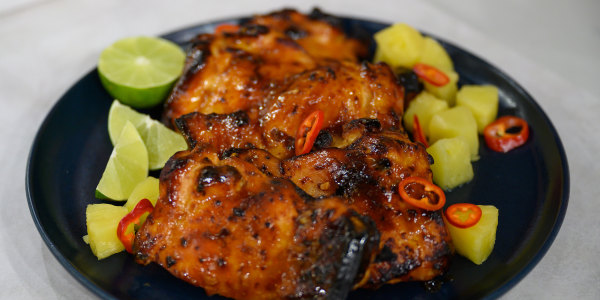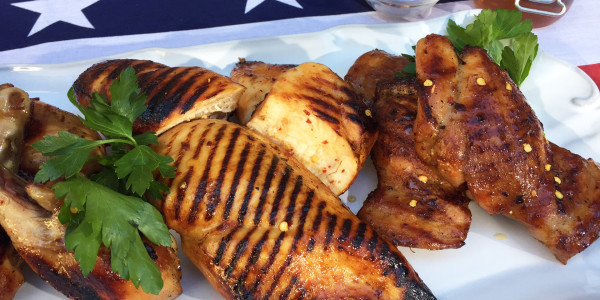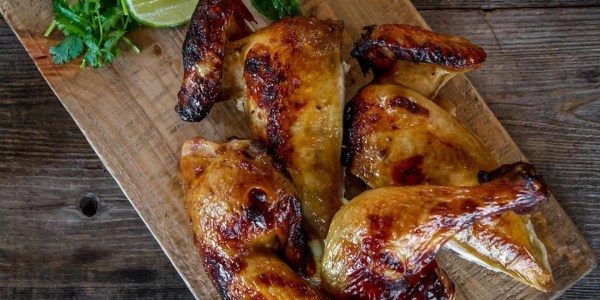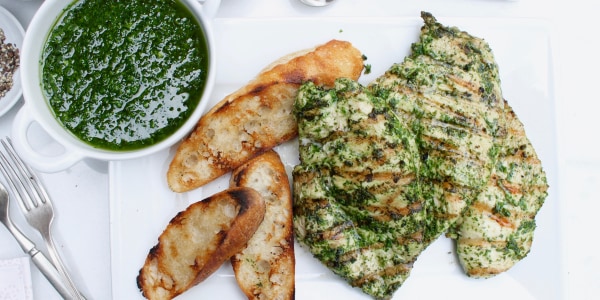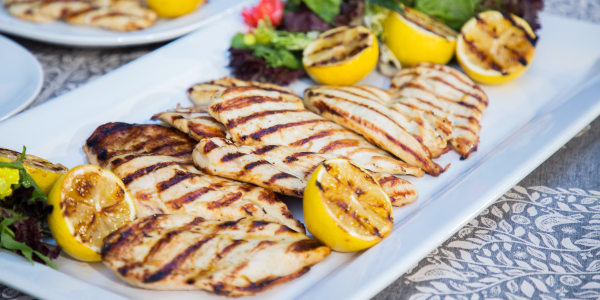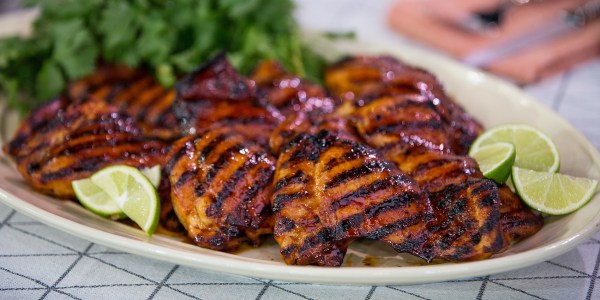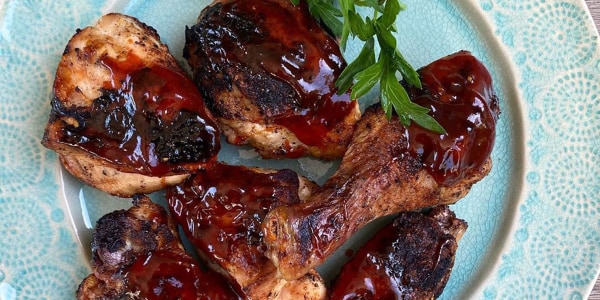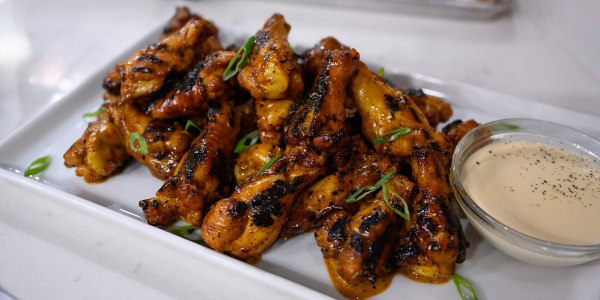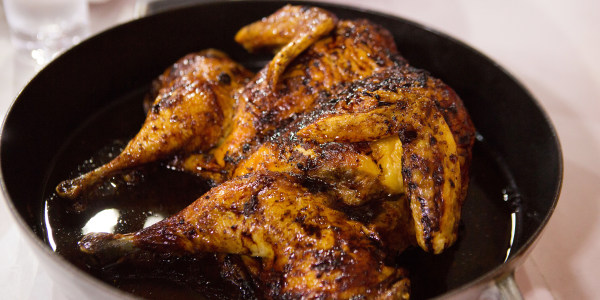Grilled chicken — specifically grilled chicken breast — gets a bad rap.
Sometimes it's well-deserved, like when a boneless, skinless breast gets cooked far too long without any tenderizing or marinating and turns out super tough. But with just a few key tips and techniques, it's possible to have moist, juicy grilled chicken — breast, thighs, wings, all of it — bursting with flavor all summer long.
Mix up a marinade, dry rub or brine
Unless glazing with a barbecue sauce, always season your chicken, whether it's boneless breasts or the whole bird. Wet marinades, dry rubs and brines all add flavor and moisture to chicken breasts and can also act as a tenderizer. Here's what to know about each type:
Marinade: A wet marinade is any type of highly seasoned liquid, such as herb or spice pastes, wines, spiced oils, vinaigrettes, yogurt/buttermilk, Cuban mojo, etc. If a marinade includes something very acidic, like vinegar, wine or citrus, keep the marinating time relatively quick — 30 minutes to three hours, depending upon the thickness of the chicken breast — and cut it with a little olive oil. Yogurt and buttermilk, which are both rich in lactic acid, are much less acidic and can stand a longer marinating time — two to six hours, depending upon the chicken's thickness. Non-acidic marinades, like herbs and spices mixed with oils, can sit for two to 10 hours.
Dry rub: A dry rub is usually a blend of dried spices, herbs, salt, pepper and sometimes sugar. The effects of dry rubs are practically instant. Chicken can marinate for minutes or hours to add even more flavor. Foods rubbed with dry spices should be cooked over indirect heat, otherwise the sugar and spices will burn.
Brine: A brine is a mixture of salt, water, aromatics and sugar. Not technically a marinade, a brine is an incredibly effective way to infuse flavor and moisture into meat, especially boneless, skinless chicken breasts. Depending upon the salt-to-sugar-to-water ratio (one part each of salt and sugar, mixed with five parts water is a great option), boneless chicken can brine for two to four hours, while bone-in can go overnight.
Cheat the marinade: Seasoned pickle juice makes a great brine or quick marinade when mixed with oil. Leftover vinaigrette or even bottled vinaigrettes are very good, too. Just be sure to read the labels — sugar can burn quickly, so pay attention when grilling.
Glaze: Love a sticky, slightly sweet, caramelized glaze on your chicken? Brush barbecue sauce on about 2 to 3 minutes before the chicken is done. That way the meat doesn't overcook and the glaze doesn't burn. Don't have any sauce? No problem. Just mix some apricot jam, a squirt of ketchup, a shot of bourbon and dash of chipotle powder for an almost–instant substitute.
Get the grill ready
Preparing the grill is as important as preparing the chicken itself. Before cooking the chicken, make sure to follow these steps:
Clean the grates: Dirty grates make foods stick. Heat the grill and brush the grates with a hard wire grill brush before and after cooking. To remove even more gunk, crumple up a damp paper bag or wet newspaper and, using tongs, rub the grates. Follow up with a damp paper towel. Once or twice each summer (or every four months, for people who grill year-round), be sure to thoroughly clean the grill. Built-up grease can cause flare-ups and fires.
Oil it: Once the grates are clean and hot, carefully rub them with a lightly-oiled paper towel that's held with tongs. Oiled grates release food much better than oiled chicken alone. Of course, it's even better to oil both.
Preheat: For a gas grill, allow 10 minutes for the grill to heat up. For a charcoal grill, preheat for about 30 minutes. Don't add food to an under-heated grill — it's guaranteed to stick. Because boneless, skinless chicken breasts are so lean (and thin, if pounded), they should be grilled quickly over high heat to retain as much moisture as possible. Chicken on the bone or large, un-pounded breasts should be grilled more slowly over medium-high heat so the outside doesn't burn while the inside reaches an internal temperature of 165 F.
Know when to open and close the grill
Closing the grill turns it into an oven, which heats everything more evenly all around. This is good for large, un-pounded breasts and bone-in chicken. Leaving the lid open concentrates the heat only at the bottom, which is best for thinner breasts so that the bottom of the piece gets that nice char without overcooking the top.
How to grill chicken breasts
When purchasing boneless breasts, cuts that are 10 ounces or more take much longer to grill and can result in dry, stringy meat. Opt for pieces that are between five and eight ounces — they'll cook faster and retain more moisture.
Breasts are naturally thicker on one end, and the large ones can vary by almost two inches from end to end, so it's smart to prepare them for even cooking. For average to smaller cuts, use a meat pounder to even out the thickness and, if grilling up something larger, butterflying is best.
To pound: Dip the breast lightly in water, set it in a quart-sized zip-top bag and pound gently with a meat pounder at a slight angle away from the body. Aim for about a 3/4-inch to a 1-inch thickness.
To butterfly: Using a sharp knife, make a horizontal cut from one side, nearly cutting through to the other. Open up the chicken like a book and gently pound the seam and thicker end to even it out. If it's done right, the breast will be heart–shaped.
To slit: Instead of butterflying or pounding, cutting shallow gashes in the meat creates more surface area and really soaks up the marinade. Rub the marinade into the cuts, about 1/4-inch to 1/2-inch deep to enjoy full flavor in every bite.
Boneless skinless breasts (pounded 3/4-inch thick) should be cooked on high heat for 10 to 12 minutes. That means there are no more than five minutes to run back into the kitchen to toss the salad or grab a platter before flipping to cook the other side. To test for doneness, carefully press the chicken at the thickest end with a finger. If there's no resistance, it's done.
A grilled boneless, chicken breast with the skin is absolutely delicious, as the crisped outside surrounds the juicy meat. Since it's nearly impossible to find boneless, skin-on breasts at a supermarket, the next best thing is split chicken breast on the bone. Ask a butcher to debone it or practice some knife skills and do it at home. Cook it the same way you would skinless, boneless breasts with the skin-side down first so it gets nice and crispy after being flipped.
For bone-in breasts, cook them in the hottest, center part of the grill on about 400 to 500 F for about 15 minutes on each side, until the internal temperature is about 155 F. The cook time depends on the size of the breast but you want the meat to look opaque through to the bone. Once it is, remove from the grill and let the chicken rest until the internal temp is about 160 F.
How to grill chicken thighs
Chicken thighs are more tender and fattier than the breast cut of the meat and are often the preferred cut of chefs. Herve Malivert, director of culinary affairs at the Institute of Culinary Education, says thighs — both boneless and bone-in — should be grilled at two temperatures for best results. First, preheat the grill to about 400 to 500 F, which depending on what type of grill you have should take about 30 minutes.
Place the chicken thighs on the hottest part of the grill (usually the center of the lower rack/main grill grates). If the skin is on, put the skin-side down first. For boneless thighs, let them cook about 3 to 4 minutes, and for bone-in, allow them to cook for about 12 minutes on each side. To check if they're ready to flip, use a grill spatula or tongs to move the chicken. If they can be pulled easily off the grates without sticking and is your desired color, they're ready to flip.
Flip the chicken and place it back on the same hot spot for the same amount of time. When the other side has achieved your preferred coloring, move the chicken to the top rack (if you have one) or a cooler part of the grill. Use a thermometer to check that each thigh has an internal temperature of 155 F, and then remove from the grill. While it rests, the chicken will continue cooking to 165 F.
How to grill chicken wings
According to Malivert, wings can use the same method as thighs, but they cook much faster. Estimate about 4 to 5 minutes total on the bottom rack and then move them up to the top rack or cooler area to finish. Again, the timing depends on the size of the chicken, but if you try to remove or twist one of the bones and it feels like it can be pulled out or separated from the meat, the chicken is done.
How to grill a whole chicken
"I’d recommend butterflying the chicken first, which (with the whole bird) entails removing the backbones and flattening it," Malivert said. "Put it on the hot part of the grill to get color and grill marks on both sides and then finish on the top rack or cooler area until the temperature reaches 155 F."
Grilling a whole chicken, even butterflied, will take approximately 35 to 40 minutes to cook fully. After you get your desired grill marks, you can also finish cooking it in the oven.
Trust the experts: A closed lid and well-timed cooking experience will make you a very happy chicken griller — and even happier diner.

